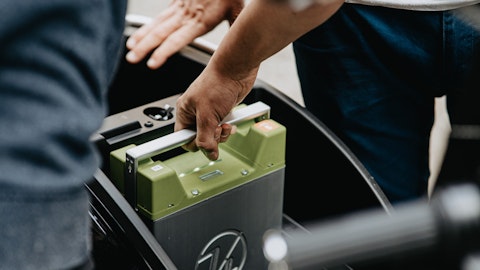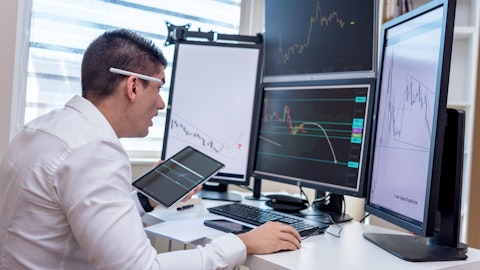Raj Talluri: Yes. So I showed EX2 as a road map to what we can get to. We will be doing something in between the EX1 and EX2 to start where we will improve the cycle life and we’ll improve the fast charge, but maybe not push the energy density all the way to it, we need to because as you saw in the slides, our EX1 energy density itself is much higher than what is shipping in the market. So we’re actually pretty confident on the technology we have. So we’ll probably get that to production first. That’s what we are in the discussion with our OEMs on how quickly they want it, which one do they want. We have programs running on that. We have programs running on EX2. So clearly, our goal is to get cells into the hands of the smartphone OEMs next year as soon as we are able to from our Malaysia line and then get ready for production by end of the year, so that will be in phones early ’25.
Gabriel Daoud: And then I guess just as a follow-up, noted the new vertical strategy, as you mentioned. Could you maybe just talk about if some of those customers that you’re focused on now? Would that include the Canaccord strategic accounts that was mentioned by the previous team. Those are the companies agreed that $200 billion of market cap, I guess. Just trying to get a sense of the MOU with Samsung, like is that moving? Are you pushing the ball down the field there with Samsung? Is there maybe anything that you could speak to there? Just curious, again, if there’s an update on specifically those six strategics that you guys have previously mentioned?
Raj Talluri: Yes. I mean, it is very consistent. If you think of strategics as having large market cap and shipping millions of units, that is what the vertical first strategy is. We are actually focused on people who can buy millions of cells from us for each product, not aggregate. So that’s very important because each product needs a custom cell of a certain shape and certain characteristics. So it’s very important that every product we make ships in the millions of units, that way we get the right ROI on that. And they’re all the top customers that we talked about. And by the way, these are the same customers that were in the funnel that we used, and it’s just that we are focusing more strongly on those and not on all the hundreds and hundreds because the opportunities have been so much that we need to pick the ones that can ship the highest volume.
Operator: Our next question will be from Gus Richard, Northland Capital Markets.
Auguste Richard: Could you guys give us a split of Army revenue and RouteJade in the fourth quarter and sort of a little bit of color on how you see RouteJade’s business in 2024?
Farhan Ahmad: Sure. I can take that. So in terms of the fourth quarter revenue, Army should be similar to third quarter plus minus some. And then the remaining should be RouteJade. So RouteJade, we have talked about $18 million annualized run rate in the first half of the year. So think of it like $1.5 million per month. And the fourth quarter tends to be a little bit stronger than that, so just a little higher maybe. So that gets it to maybe $3 million to $4 million of guidance. So that should give you color. That should give you a fourth quarter revenue and the breakup. Talking about ’24, we should expect some growth from 2023. So we talked about an $18 million annualized run rate in the first half of the year. And so from that ’24, we should expect more growth.
We should expect some growth in revenue from that number. As we have talked about it, this is a company with a very good cost structure. It’s in a remote part of Korea. So the cost structure, what they’re paying per employee is actually very good. And even at that level of revenue, the profitability is comparable to what you see with the large companies in the graphite space. And so very competitive cost structure there.
Auguste Richard: And then in terms of production and shipments out of Fab 1, can you give us just the numbers for what you produced in the quarter and what you shipped?
Raj Talluri: The number we produced in the quarter [indiscernible]. I think we talked about what we produced. And I don’t know exactly how much we shipped and how much we need. But we kept quite a bit in inventory because, as I mentioned, we have to make sure that we’re not making any more of those in third quarter. So we need to make sure we have enough to satisfy the needs of the people that have already designed us in. So some of it is we are holding to satisfy that market. And some also we are using for our experiments quite a bit. For our EX1.5, EX2, we need a lot of cells to do that. So that’s where majority of that sales went.
Operator: Our next question will be from Ananda Baruah, Loop Capital Markets.
Ananda Baruah: So on PCs rise, I think you had mentioned PC kind of is a volume revenue in ’26. And so is it ’25 when you start volume sampling on the PC side? And then how does AI PCs kind of play in as well, like folks like HP has talked about? I think in three years, they expect 40% of their PCs to be AI-enabled. And so does that play into the demand backdrop as well for PC10 demand backdrop? And then I have a quick follow-up.
Raj Talluri: Yes. Good question on this. So the key thing about the PC market is the time it takes to qualify the customer is actually much longer, even longer than smartphones, just in terms of the qualification process that they go through in that market. So we will be sampling them in ’24 actually, and also more in ’25. But by the time they get to production, volume production, meaningful billions of units of production, it will be ’26. But some of the PC makers may actually go to production sooner, I’m hoping in ’25 using our smartphone like cells. So that’s kind of how I see that. But your point on AI PCs is actually clearly what has been tremendously exciting for us because as you saw in the slide that I showed, when you run AJI, it just hogs the battery like there’s no tomorrow.
And that’s why we are seeing a lot of interest from the PC OEMs actually wanting a higher capacity battery. The use cases are a little bit different. For example, how long they keep it, how many cycles it needs to charge. Fast charge is not a big requirement like in the phone. So we are optimizing our recipes to actually target those more precisely. So we can give them more energy density, maybe give them less fast charge and so on. But that’s another super exciting market for us because of this push of AI into the edge.
Ananda Baruah: And then just a quick follow-up. Ajay, you mentioned — I forgot the exact language on yields, but it’ll take a little bit, I think you said to get to the 90s. Do you think you would be at the 90% yields when you’re going to volume in ’25 on smartphones?
Ajay Marathe: Yes, absolutely, Ananda. The plan right now to which we are tracking, we will get to the 90-plus percent closer to the high 90s before the actual good, nice ramp begins on line 1, so yes. FY ’25? Yes, absolutely in the high 90s.
Operator: Our next question will be from Chris Souther, B. Riley.


